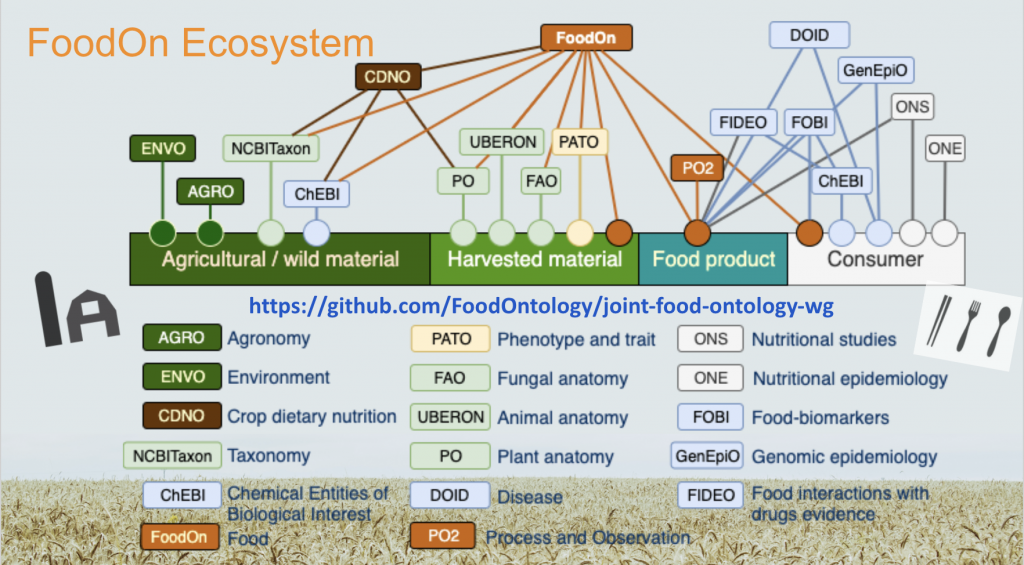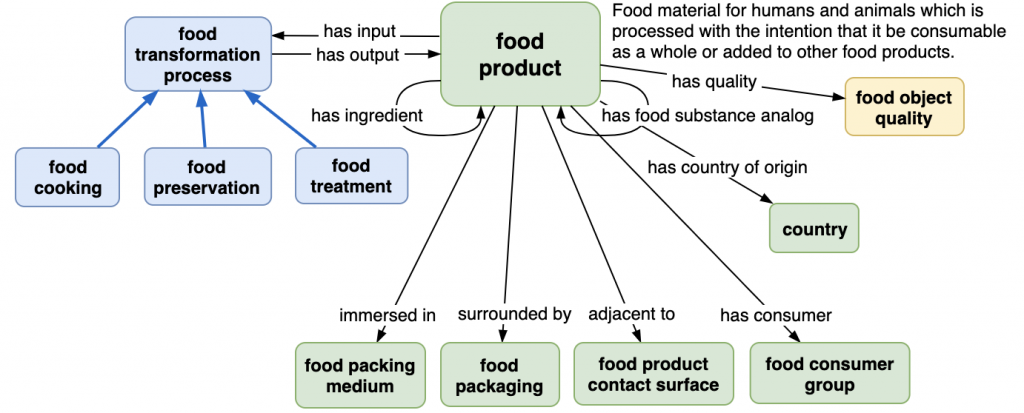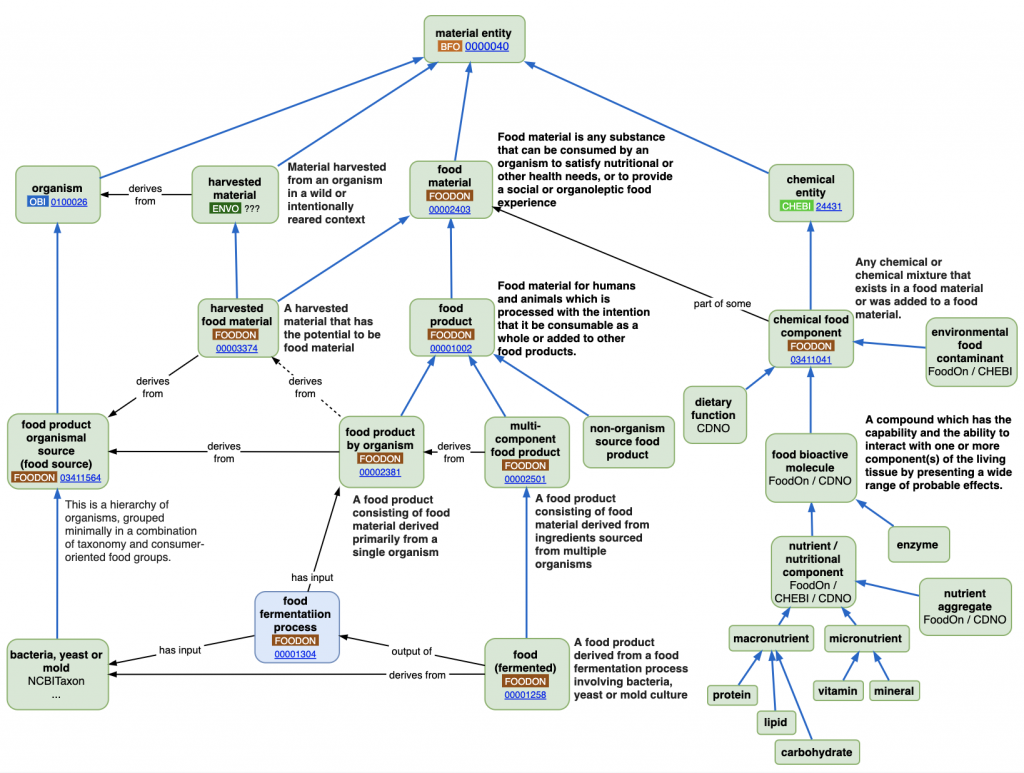The need to represent knowledge about food is central to many human activities including agriculture, medicine, food safety inspection, shopping patterns, and sustainable development. FoodOn is an ontology – a controlled vocabulary which can be used by both people and computers – to name all parts of animals, plants, and fungai which can bear a food role for humans and domesticated animals, as well as derived food products and the processes used to make them. The ontology can be used like a grammar to construct statements about the world and food in particular, statements which can be entered in a database and queried or reasoned about.
An OBO Foundry ontology
FoodOn belongs to the open source OBO Foundry consortium of interoperable life science oriented ontologies and consequently supports FAIR data annotation and sharing objectives across a wide variety of academic research, government and commercial sectors. We work to ensure these ontologies resemble an encyclopedia sharing common relationships and distinctions about material entities, characteristics, processes, and information, rather than as “stand alone” ontologies which are usable in a narrow domain but involve paradigm translation issues when the federation of other ontology enhanced data is attempted. There is a short introduction to ontologies page for those who need it.
The diagram below presents a simplified ecosystem of domains that food related OBO Foundry ontologies cover.

- FoodOn reuses terms from OBO Foundry ontologies such as environmental terms from ENVO, agriculture terms from AGRO, plant and animal anatomy terms from UBERON, and PO, organisms from NCBITaxon, relations from RO, and nutritional components from CDNO.
- Conversely, FoodOn terms are reused in a growing list of ontologies such as ENVO, CDNO, ONE, ONS, FIDEO, FOBI, ECTO, and DOID.
Food facets
We aim to develop semantics for food safety, food security, the agricultural and animal husbandry practices linked to food production, culinary, nutritional and chemical ingredients and processes. This involves the incremental development of facets – or branches – of the ontology dedicated to terms focusing on a particular subdomain. At its launch in 2018, FoodOn was based largely on LanguaL, a descriptive food indexing system that has 14 facets for describing food source plant and animal organisms, food preservation, cooking, packaging, consumer groups, labelling, etc. (a great presentation on LanguaL is here; its origins stretch back to the 1975 US FDA CFSAN Factored Food Vocabulary). We are expanding existing facets and adding new ones.
The following diagram shows a number of facets that FoodOn provides, and the relations that can attach them to a food product in a graph database. An extensive list of food processes are available to connect food products together along the supply chain from harvest to consumption. Contextual packaging details and other qualities of consumer-ready products can be described. This kind of information can be useful directly for standardized product description, but also to address many other agricultural, food science, and epidemiology research topics ranging from nutritional content and shelf-life, to contaminated food trace-forward and trace-back investigations, antimicrobial resistance and one health initiatives.

FoodOn’s own product hierarchy is not often detailed to the degree shown above. FoodOn’s primary object is to provide the vocabulary to describe food; a secondary objective is to provide commonly referenced food products.
FoodOn food products
FoodOn has gone one step further than LanguaL in offering up as part of the ontology a set of over 9,600 generic food product categories. A given food product can be linked to any one of the FoodOn facets. The objective of this evolving food product branch is to provide unambiguous, easy to reference common but generic food products, for example, a can of kidney beans – but not a can of 99% fat free black beans produced by a certain manufacturer. We do aim to have FoodOn provide the vocabulary for a brand product level of detail (for example, fat content, organic, genetically modified, fortified with Vitamin D etc.), and we welcome partners who guide FoodOn to cover their needs. FoodOn curators will gradually enhance its products with other rich information, including for example, its key ingredients, links to corresponding USDA FoodData Central food sample data, and Wikipedia pages and images.
Basic food reference

One of our current development effort is to detail the basic plant or animal organism food items used to make more complicated food. Here a food product term might reference an organism as a whole, like a sardine, or some part of an organism – like a fungus fruitbody (the harvested part of a mushroom) or an anatomical animal or plant part from an organism. Note how terms from different ontologies – FAO, PO, UBERON, NCBITaxon – are being reused within FoodOn to describe organism parts.

The following apple example should give a sense of how each food product can be enhanced by referencing facet vocabulary. The diagram shows a Fuji apple class under a generic apple (whole)” term. Generally, apples derive from (are harvested from) the “Malus domestica” species, of which FoodOn’s cultivar “Fuji apple tree”, is a subclass.
Note that if we let our food product reference be as simple as the one shown to the right, then it is still ambiguous whether the Fuji apple is still on the tree or not! To address this, we need a “harvesting status” facet that allows us to link an organism x anatomical part to a “harvested food material” to say that the organism or its part has been removed from its rearing context.

As a consumer we still might be disappointed – what if the apple needs to ripen still? We need a “degree of plant maturity” facet to cover fruit and some kinds of vegetables (shown on right as a snapshot of an ontology editor view) to which a given food product, like an apple, can be linked (via subclass or a relation like ‘has quality’).
Food nutritional analysis
FoodOn works in partnership with other OBOFoundry related ontologies (see the Joint Food Ontology Workgroup) to provide vocabulary for nutritional analysis, including chemical food components which are factors in diet, health and plant and animal agricultural rearing research. This diagram shows a DRAFT of the emerging FoodOn structure. The current published design can be found here.

Explore FoodOn
The ontology can be explored with an ontology lookup service:
- EMBL-EBI Ontology Lookup Service
- He Group (University of Michigan Medical School) OntoBee
- National Center for Biomedical Ontology BioPortal
- LIRMM (University of Montpellier) AgroPortal
FoodOn resources
- Curators and implementers can read up on FoodOn’s design details.
- The FoodOn GitHub repository has the latest live and /src/ontology development ontology files.
- The GitHub issue/term request board is a great place to request new terms or request discussion on topics.
- An email FoodOn discussion group carries new announcements.
- Ways to incorporate portions of FoodOn into systems are described on the reuse page.
- A series of videos from the 2020 Integrated Food Ontology Workshop are available on YouTube that show FoodOn and other interoperable ontologies working together within the OBOFoundry community. A Joint Food Ontology Workgroup GitHub page shows discussion within this community, as well as IFOW 2020 conference abstract and slide deck presentations.
- Occasionally videos from biweekly and monthly working groups on FoodOn curation, a food processing ontology development group and some JFOW discussions are available on this YouTube channel.
Image credits: centre photo © Roger A Smith (cc-by-sa/2.0)